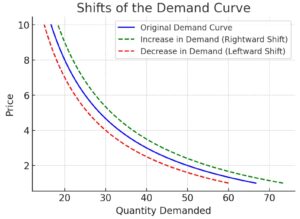Shifts of the demand curve occur when there is a change in the quantity demanded at every price level due to factors other than the price of the good itself. Understanding demand curve shifts is essential for businesses, economists, and policymakers to predict market trends and make informed decisions. These shifts can be caused by various factors, including changes in consumer preferences, income levels, the prices of related goods, and expectations about future prices. By analyzing these shifts, stakeholders can better anticipate changes in demand, adjust their strategies, and make more informed decisions to optimize market outcomes and achieve economic stability.
1. What Are Shifts of the Demand Curve?
A shift of the demand curve means that at every price level, the quantity demanded changes due to external factors such as changes in income, preferences, population, and other non-price factors. This differs from movements along the demand curve, which are caused by price changes.

A. Key Features of Demand Curve Shifts
- Entire Curve Movement: The curve shifts left or right.
- Non-Price Factors: Caused by changes other than the price of the good.
- Dynamic Nature: Reflects changes in market conditions and consumer behavior.
2. Types of Demand Curve Shifts
A. Rightward Shift (Increase in Demand)
- Definition: More quantity demanded at every price level.
- Causes: Higher income, favorable preferences, lower prices of complementary goods, and population growth.
B. Leftward Shift (Decrease in Demand)
- Definition: Less quantity demanded at every price level.
- Causes: Lower income, unfavorable preferences, higher prices of complementary goods, and economic downturns.
3. Causes of Demand Curve Shifts
A. Changes in Income
- Factor: Higher income increases demand for normal goods and decreases demand for inferior goods.
B. Changes in Consumer Preferences
- Factor: Trends, marketing, and societal influences can increase or decrease demand.
C. Prices of Related Goods
- Substitutes: A price increase in a substitute raises demand for the good.
- Complements: A price increase in a complement decreases demand.
D. Population Growth
- Factor: More consumers lead to higher demand.
E. Expectations of Future Prices
- Factor: Expectations of rising prices increase current demand.
F. Government Policies
- Factor: Taxes, subsidies, and regulations impact demand levels.
4. Impact of Demand Curve Shifts on the Market
A. Price Changes
- Impact: Increased demand raises prices, while decreased demand lowers them.
B. Production Adjustments
- Impact: Businesses adjust production based on demand shifts.
C. Consumer Behavior
- Impact: Demand shifts influence purchasing patterns.
D. Business Strategies
- Impact: Companies revise marketing, pricing, and inventory strategies.
5. Elasticity and Demand Curve Shifts
A. Price Elasticity of Demand
- Role: Measures responsiveness of demand to price changes, influencing the magnitude of shifts.
B. Income Elasticity of Demand
- Role: Indicates how demand changes with income variations.
6. Real-World Examples of Demand Curve Shifts
A. Technological Advancements
- Example: Demand for smartphones increases with new features and innovations.
B. Health Trends
- Example: Rising health awareness increases demand for organic foods.
C. Economic Events
- Example: Recession reduces demand for luxury goods.
7. Challenges in Analyzing Demand Curve Shifts
A. Market Volatility
- Challenge: Rapid changes in market conditions complicate demand analysis.
B. Data Limitations
- Challenge: Obtaining accurate demand data is often challenging.
C. External Factors
- Challenge: Unforeseen events like pandemics impact demand unpredictably.
8. The Significance of Demand Curve Shifts in Economics
Demand curve shifts provide valuable insights into consumer behavior, market trends, and economic conditions. Recognizing and analyzing these shifts is crucial for businesses, economists, and policymakers to ensure effective decision-making, resource allocation, and market stability.